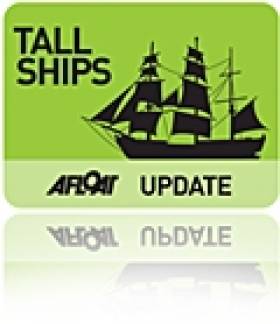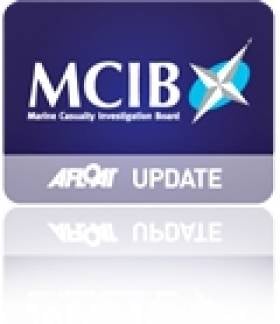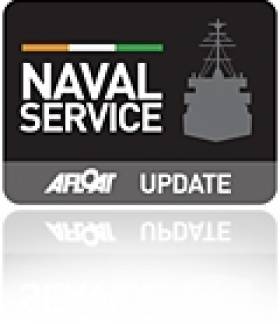Displaying items by tag: LE Emer
Dublin’s Tallship Link to Parade of Sails Naval (Guard) Ships
#TALL SHIPS – At the Dublin Tall Ships Races Festival, the docklands-based replica 19th century barque Jeanie Johnston was open to the public, however a former Irish Naval Service vessel, could of been there in her place, had circumstances in the past had taken a different course, writes Jehan Ashmore.
Since 2005, the Jeanie Johnston has been owned by the Dublin Docklands Development Authority (DDDA) which as part of its remit was to regenerate water-borne activity along the Liffey. In May this year it was announced the authority is to be wound-down over a period of 18 months.
The Jeanie Johnston currently serves as a static floating emigrant famine museum. This is a stark contrast to when the barque made a historic re-enactment voyage in 2003 of her predecessor which carried Irish emigrants across the Atlantic, between 1845-1855 to Quebec, Baltimore, and New York.
Prior to the acquisition of Jeanie Johnston by the DDDA, the L.E. Deirdre (P20) was decommissioned four years previously when the Naval Service put her up for auction. She is an elder half-sister of the L.E. Emer (P21) which performed 'guardship' duties during last Sunday's Parade of Sail off Dun Laoghaire Harbour.
Notably the L.E. Deirdre is historically significant in that she was the first custom-built newbuild for the Naval Service and also the first such vessel built in the country, at Verolme Cork Dockyard in 1972, however despite campaigns to keep her as part of our national maritime heritage, this did not materialise, as she was sold at a bargain price of £180,000 to a UK company.
Initially this saw the vessel go to the ship-repair yard of Pomerania, in Szczecin, ironically the Polish city which was the presenting sponsor of the Dublin Tall Ships Races Festival in association with Sail Training International (STI).
However the owner of the former Naval Service vessel, died in 2004, and work on transforming the offshore patrol vessel into a luxury charter yacht, which included installing a helicopter landing pad, came to a standstill. She was sold again and towed to Brazil in 2005 where it is believed the 220ft vessel renamed Santa Rita, painted beige replacing the dull naval grey, was to be completed in 2010.
Yesterday L.E. Emer departed Dublin Port to resume routine patrols and the last large tallship to bid the capital farewell, the A-class, Italian Navy's Amerigo Vespucci, was underway last night. This leaves the Swedish Navy's gaff schooner Falken (class-B) as the last of the tallships still in port.
Report into Death of Crab Fisherman Prompts Call for Review of Stability Standards
#MCIB - The Marine Casualty Investigation Board (MCIB) has recommended a ministerial review of stability standards for fishing vessels following its report into the death of a crab fisherman off Co Cork in January last year.
Gerry Hegarty drowned after a wave struck the crab boat Carraig An Iasc, which was fully loaded with crab pots at the time, causing it to capsize and sending its two-man crew into the water.
Hegarty, who was not wearing a personal flotation device (PFD) or other buoyancy aid, got into difficulty while attempting to swim ashore with his crewmate and skipper James Fitzgerald, who subsequently raised the alarm.
Lifeboats from Ballycotton and Crosshaven, as well as Irish Coast Guard helicopter Rescue 117, were tasked to the incident. Divers from Naval Service vessel LE Emer located the sunken crab boat but no body was found.
A coastguard search of the area continued over a number of days without success. Hegarty's body was eventually recovered on 17 February 2011 at Ringabella Strand in Co Cork.
The MCIB found it probable that the Carraig An Iasc encountered wind or wave action or a combination of both that caused the vessel to heel to an angle beyond which it was able to recover from its loaded condition. The vessel's Code of Practice Declaration of Compliance was valid until 15 July 2013.
The board noted that there have been "a number of incidents caused by overloading boats thus effecting stability", and recommended that the Minister for Transport reviews and revises the stability standards in the current Code of Practice to improve these standards.
It was also recommended that a safety notice be issued to all skippers and owners in the fishing fleet reminding them of their legal responsibility to ensure that all their crew wear PFDs or lifejackets while on deck.
The full report is available to download as a PDF from the MCIB website HERE.
- Crosshaven
- Cork
- Safety
- Fishing
- Ballycotton
- Lifejacket
- Lifeboat
- Marine Casualty Investigation Board
- Coastguard
- Irish Coast Guard
- Skipper
- naval service
- helicopter
- MCIB
- Rescue 117
- personal flotation device
- Minister for Transport
- LE Emer
- standards
- drowned
- crab fishing
- Carraig An Iasc
- Gerry Hegarty
- James Fitzgerald
- PFD
- Ringabella Strand
- Code of Practice
- stability
- overloading
LE Ciara Returns to Sea after Hull Repairs
#NAVAL SERVICE- The Naval Service patrol ship LE Ciara (P42) has been cleared to return to sea, following repairs to a hole in its hull, the Irish Times reports.
The high-speed coastal patrol vessel (CPV) is the latest in a series of vessels in the fleet which have required substantial repair due to a combination of age and rough Atlantic conditions.
The oldest ships of the eight-strong fleet, the sisters LE Emer , Aoife and Aisling , have all suffered plate erosion due mainly to age. The service is due to received two new ships at €50 million each, which will be commissioned in 2014 and 2015, under a deal with British shipbuilder Babcock Marine.
Navies Northern Adventure Head for 'Foyle Days'
On the naval front, LE Emer was built in Cork's Verolme Dockyard in 1978. She represents the oldest of the eight-strong fleet and is designed from the Naval Service's first purpose built patrol vessel OPV LE Deirdre (P20) but was modified to improve her stability and speed. This vessel was decommissioned several years ago and was converted into a private yacht.
The original BOFORS 40mm L60 gun of the LE Emer was recently upgraded to a BOFORS 40mm L70 to improve range and accuracy of her main armament. She alongside her 65m sisters LE Aoife (P22) and LE Aisling (P23) where all built primarily to patrol the Irish section of the European Economic Zone (EEZ).
During their careers the 'Emer' class vessels have also completed numerous re-supply missions to Irish troops serving overseas with the United Nations and in particular in the Lebanon. A crew compliment of 46 (5 officers) operate the vessels which are all now in their fourth decade of service.
OPV HMS Severn is the third of four 'River' class offshore patrol vessels and like her Irish counterpart is deployed on fishery duties. The 1,677 displacement tonnes vessel was built in 2001 in the UK'S south coast port of Southampton at Woolston Docks. Her home port for the 30 crew is at HM Naval Base in neighbouring Portsmouth.
She becomes the fifth ship to bear the name and with sisters HMS Mersey (P 282) and HMS Tyne (P 281) they are assigned to the Fishery Protection Squadron. Click the ship's diary to follow the ship news. The final member of the River class HMS Clyde (P 257) serves as a Falklands Islands Patrol Vessel (FIPV).
- yacht
- Clipper Round The World Race
- naval service
- Derry
- Royal Navy
- Londonderry
- Ports and Shipping News
- JOHANNA LUCRETIA
- Verolme Cork Dockyard
- United Nations
- Foyle Days
- Offshore Patrol Vessel
- Maritime Festivals
- LE Emer
- Emerclass
- LE Deirdre
- HMS Mersey
- Riverclass
- Schooner
- HM Naval Base Portsmouth
- Falklands Islands
































































